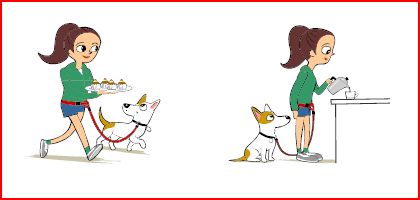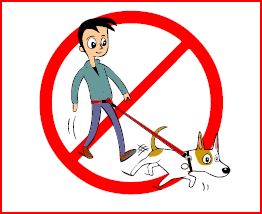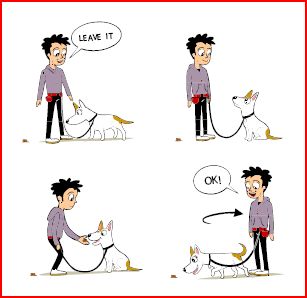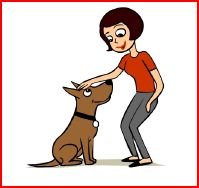In the last blog, I presented an overview and the reasons behind my version of the Learn to Earn Program. In this blog I will cover the basic steps.
#1 First Teach Your Dog to Automatically Say Please By Sitting for Treats
(Read Perfect Puppy in 7 Days, section 5.2 and watch Say Please By Sitting).
Just hold a treat when you have a hungry dog (on leash) and quietly wait for her to sit. Once she sits, immediately give her a treat (kibble or treats) followed by a few more sequentially for remaining seated. Then take a few steps backwards, far enough so she has to get up and follow, and repeat the exercise. Repeat the exercise 5–10 times and stop while she still wants to play more.
Randomly play this repeat sit game during the day. The goal is that she thinks sitting is fun and trotting after you and sitting fast becomes a game. Even try to get 10 repeat sits in a minute. When she can do this easily, start rewarding her on a variable ratio where she may get rewarded every 1–3 times she performs the behavior correctly. For ways to make sit even more fun and compelling, read section 5.2.2 in Perfect Puppy in 7 Days.
#2 During the Day Keep Her Tethered to You When You’re At Home (or to furniture close by when you’re at home) and Reward Her For Saying Please Until the Behavior Becomes a Habit
For many dogs, once they know the sit-for-treats exercise well, which usually takes just 5–15 minutes, they are ready to be tethered to you when you are at home in situations where they would have access to interacting with you. Tethering allows you to reward Fido with treats (kibble) for sitting repeatedly so that she learns sitting and focusing on you is fun. If she tries to nudge, paw, or jump on you to get the treats, stand still like a tree and ignore her until she sits. For instance, if you’re working at your desk and she puts her paw on your lap, immediately stand up so it’s clear that doesn’t work. Then, when she sits and looks at you, give her a series of treats. Or if you walk to the kitchen and clean the counters and she sits, reward her with a series of treats. As she improves, use fewer treats and space them further apart.
When your dog’s attached to you on leash, she should sit and remain seated when you are stationary and then walk by your side on a loose leash (not ahead of you) when you move from place to place. Choose the same walking side you use when you take her on walks.
If your dog tends to dash ahead, remember to always stop in your tracks immediately as her front feet get ahead of yours, even before she has a chance to get to the end of the leash. That way by the time she does get ahead, it will be clear to her that you have become firmly planted like a pole and are going nowhere until she comes back and sits in front of you.
Your dog’s response after a couple of days to a week will provide clues as to how consistent you’ve been. If when she hits the end of the leash she comes back to sit and look at you, you’ve done a great job. If, when she hits the end, her first reaction is to pull harder, you know you’ve accidentally trained her that pulling gets her where she wants to go.
NOTE: Many owners will need to practice the leave-it version 2 below as well as one or two heeling games (such as repeat sits on the left side and rewarding walking at attention) before their dogs are ready to be tethered to their owners while the owners are walking around the house.
NOTE: When the dog is tethered to furniture near the owner, the dog can have a toy for entertainment.
#3 Apply the Say Please by Sitting Exercise to the Game of Leave-it Version 1
(For a more complete version of this exercise read Perfect Puppy in 7 Days section 5.4) and watch Dog Training Demo: Leave It).
This exercise teaches the dog to 1) look to you for guidance in new situations, 2) that she can’t get what she wants unless she asks you for permission anyway, 3) that blocking means she can’t get by, and 4) that a release word such as “ok” means she can have what she wanted.
Toss a treat on the ground and then block her from getting it. If she tries to make a dash, quickly sidestep (like a basketball player on defense) to make your block. Avoid grasping her leash with your hands (in basketball you’re not allowed to grab!). Each time she makes a move, thwart her by positioning yourself in her path fast enough so that she knows you mean business. Because you’re not confusing her with distracting chatter (e.g. you are completely silent), she’ll figure out that she can’t get to what she wants and then sit and look at you. Immediately give her a treat while she’s still sitting and then give a few more for remaining seated. When she’s stably looking at you instead of the treat on the floor, move aside so she has a clear path to the treat but be ready to block her again if she starts to get up. Give her a series of treats for looking at you and when she’s stably looking at you then release her with an “ok” and point to the treat to indicate she can get up and get it. Repeat this exercise until she immediately sits and remains focused on you until you give the release (generally at least 5–20 practice trials). At that point you can add a cue word “leave-it” right before you drop treats so that she learns leave-it means sit patiently and look to me for permission and you might get the opportunity to have it.. You can also start practicing in more realistic settings, such as by randomly dropping food in the kitchen or a toy in the living room, telling her to “leave-it” and then blocking her if needed so she doesn’t get it.
#4 Then add the Leave-it Game Version 2
In this version you toss the treat out of leash range and then stand completely still. When Fido pulls to the end of the leash and you fail to budge, she’ll soon figure out pulling gets her nowhere. Since she’s been rewarded so much for sitting and looking at you, she’ll turn back and sit in front of you. Give her a sequence of treats and then when she has a stable “watch” then say the release word and point to the treat. Make sure she can get to the treat on a loose leash or you will have negated what you just did. Note that this exercise helps teach Fido that when she gets to the end of her leash she should turn and then sit and look at you.
#5 Now Require That Your Dog Sit Politely for Everything She Wants.
(For more detailed instruction read section 5.3 in Perfect Puppy in 7 Days)
Say please by sitting automatically to be petted: This is the most difficult exercise for people because humans tend to pet their pets without thinking. So it’s an exercise for humans to be aware of when they are unconsciously rewarding the wrong behaviors. This exercise is especially important for dogs that jump on people for attention or that are highly motivated for petting and attention and anxious when they don’t get it when they want it (such as with separation anxiety). In this exercise only pet your dog when she’s sitting. Pet in short 5 seconds bouts so that you can reward her for remaining sitting. Remove your hands and even stand up straight and look away if the dog even starts to get up. For wiggly dogs you can start by giving treats while simultaneously petting so the dog will hold still, and stop the petting and treat giving at the same time. Then work towards petting followed immediately by giving treats before the dog starts to wiggle. Then pet while the dog’s getting treats but space the treats out in time. Then stop giving treats altogether and just reward with the petting. For dogs that are really wiggly, hyperactive, or anxious, require that they lie down instead of sitting to be petted.
Say please by sitting automatically to get the leash on or have taken off: Wait for your dog to sit politely before you go to put the leash on. If needed, you can give treats while putting the leash on. If treats are needed, practice putting the leash on at least 5–10x in a day. That way, by day two or three, treats will no longer be required.
Say please by sitting automatically to go through door: The leave-it technique applies to waiting to go through doorways. Instead of letting Fido rush past you, first wait until he sits to open the door. Then when you open the door, block him, as you learned in the leave-it exercise from coming out. Only let him through the door when he’s sitting stably and focused on you.
Say please by sitting automatically to get out of the car: If your dog loves riding in the car, and in particular getting out, then have her sit patiently before you let her out of the car. Again use the blocking exercise to train this. Ultimately the goal is she automatically sits and waits for your release word and doesn’t need any treats.
Before you toss a toy: When Fido wants to play fetch, wait until he sits to toss the toy to him. If he has huge arousal issues around toys, then actually teach him to sit or lie down and remain seated even after you toss the toy. This exercise is particularly important for dogs that get more aroused and unruly during or after playing fetch and with those who are possessive over their toys.
Say please by sitting in order to get you to approach: For dogs that are overly dependent and who whine or bark when you are out of their reach because they want your attention, tether them to furniture and walk away. Then go up and pet them only if they will sit when you are just outside of their petting range. When they understand this association, then graduate to expecting them to sit if they want you to approach. That is, we want them to learn that whining, barking, and howling do not work to get your attention; rather, sitting or lying down and controlling their emotions is what gets you to approach and pet them.
These are the standard times when dogs should say please by sitting but also tailor the “please” to your needs. Some dogs may need to understand in additional situations (such as coming out of their crate ) that they only get what they want when they are calm and collected. Overall these exercises will help your dog be calmer, more focused and exhibit better self control. As a result he’ll be able to be more attentive to your signals and directions.
Conclusion: That’s the basic overview of the program. For exercises in detail read
This book is appropriate for puppies as well as adult dogs and their owners. This plan as detailed above will provide you with a dog who’s focused on you inside which will you can then use to build on his focus with you outside and in more distracting situations.
To download the free poster on The Learn to Earn Program, go here.
Stay tuned for the next blog where I answer some common questions about the Learn to Earn Program.







